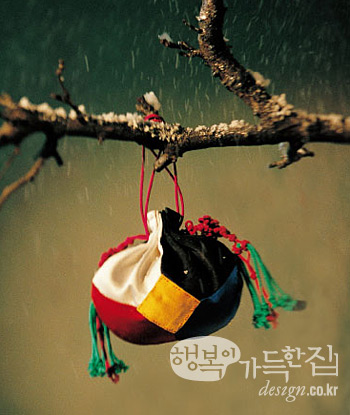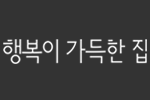 Since ancient times, the Korean traditional color scheme was inspired by the concept of Eumyang-Ohaeng, yin and yang, and the five elements. This color scheme presents a belief that the world originated from two forces, yin and yang, and these forces created the five elements or Ohaeng, namely wood, fire, earth, metal, and water. Based on Ohaeng, the basic, traditional Korean colors are the Obang colors, which literally mean “the five directions of color”. The five directions are center, north, south, east, and west, and five colors are assigned to these directions, namely yellow (center), blue (east), white (west), red (south), and black (north). When we look into the meaning of Obang colors based on the Eumyang-Ohaeng theory, yellow symbolizes the earth, which corresponds to the center of the universe. Yellow was mostly used on kings’ clothes because it was considered as one of the noblest colors. Blue, which means wood and east, symbolizes spring when everything comes alive. It signifies the creation and life and when wishing for good luck. White is the symbol of metal, fall, and west. Red stands for fervor, affection, and initiative such as the sun, fire, and blood. It’s the color that exorcises evil spirits. Black, which represents water and the north, controls human wisdom.
Since ancient times, the Korean traditional color scheme was inspired by the concept of Eumyang-Ohaeng, yin and yang, and the five elements. This color scheme presents a belief that the world originated from two forces, yin and yang, and these forces created the five elements or Ohaeng, namely wood, fire, earth, metal, and water. Based on Ohaeng, the basic, traditional Korean colors are the Obang colors, which literally mean “the five directions of color”. The five directions are center, north, south, east, and west, and five colors are assigned to these directions, namely yellow (center), blue (east), white (west), red (south), and black (north). When we look into the meaning of Obang colors based on the Eumyang-Ohaeng theory, yellow symbolizes the earth, which corresponds to the center of the universe. Yellow was mostly used on kings’ clothes because it was considered as one of the noblest colors. Blue, which means wood and east, symbolizes spring when everything comes alive. It signifies the creation and life and when wishing for good luck. White is the symbol of metal, fall, and west. Red stands for fervor, affection, and initiative such as the sun, fire, and blood. It’s the color that exorcises evil spirits. Black, which represents water and the north, controls human wisdom.Obang colors are closely related to our daily lives. The color red is believed to drive away bad luck and harm. A bride on her wedding day wears rouge on her cheeks. Red peppers are threaded on a gold string and placed around the crock for soy sauce on the wedding day. In addition, a red talisman was attached on the gatepost and Patjuk (red adzuki-bean porridge) was sprinkled on every corner of the house during the winter solstice. The idea of Ohaeng in wishing good health and long life can also be shown in the rainbow-colored Hanbok that children wear on their first birthday and during holidays. The same goes for the five-colored garnishes on noodles served during traditional feasts. The bright and colorful Obang colors were often used in the daily traditional necessities. In particular, Korean patchworks represent the beauty of Obang colors. Our ancestors made good use of Obang colors as a symbol of the thought of Eumyang-Ohaeng, not to mention the pursuit of beauty. Obang colors are considered not simply as colors, but as tokens to wish good fortune and to drive out evil spirits.
우리나라에는 고대부터 음양오행 사상에 근거한 색채 문화가 있다. 음양오행 사상은 음과 양의 기운이 생겨나 하늘과 땅이 되고, 다시 음양의 두 기운이 목 木 ㆍ화 火 ㆍ토 土 ㆍ금 金 ㆍ수 水의 오행을 생성하는 것을 말한다. 오행에 따른 우리 전통 색의 기본은 오방색. 오방색은 말 그대로 풀면 다섯 가지 방향의 색을 뜻하는 것으로, 중앙과 동서남북 다섯 방향을 기본으로 오방을 설정하고 이 방위에 따라 오색을 배정했다. 오색은 황, 청, 백, 적, 흑. 즉 황색은 중앙, 청색은 동쪽, 백색은 서쪽, 적색은 남쪽, 흑색은 북쪽을 나타내는 것. 음양오행에 따른 오방색의 의미를 살펴보면, 황색은 오행 가운데 토로 우주의 중심에 해당한다. 가장 고귀한 색으로 예부터 임금의 옷을 만들 때 주로 사용했다. 청색은 오행 가운데 목으로 동쪽에 해당하며, 만물이 생성하는 봄을 상징한다. 창조와 생명을 뜻하며, 복을 비는 색으로 사용되었다. 백색은 오행 가운데 금으로 가을과 서쪽에 해당하며, 결백과 순결을 뜻한다.적색은 오행 가운데 화로 태양 ㆍ불 ㆍ피와 같이 정열과 애정, 적극성을 뜻한다. 흑은 오행 가운데 수에 해당하며 방위는 북쪽, 인간의 지혜를 관장한다. 이러한 오방색은 우리의 생활과 밀접한 관련을 맺고 있다. 적색은 액을 쫓는 색. 해로운 기운을 물리친다고 믿어 혼례를 치를 때 신부가 연지 곤지를 바르고 간장 항아리에 붉은 고추를 꿴 금줄을 둘렀다. 문기둥에 붉은 부적을 붙이거나 동짓날이면 팥죽을 끓여 집 안 구석구석에 뿌리기도 했다. 돌이나 명절에 어린아이에게 입히는 색동저고리, 잔칫상 국수에 올리는 오색 고명 역시 무병장수를 기원하는 오행 사상을 담은 것. 밝고 화려해 전통 생활용품에 많이 사용되었는데, 특히 알록달록한 조각보는 오방색의 아름다움이 그대로 담긴 전통 소품이다. 우리 선조에게 오방색은 생활 속에서 아름다움을 추구하는 요소로 사용했을 뿐 아니라 음양오행 사상을 표현하는 상징적 의미로 이용해온 것. 단순한 빛깔로서 색만이 아니라, 복을 기원하고 나쁜 기운을 몰아내는 역할까지 했다. 







